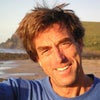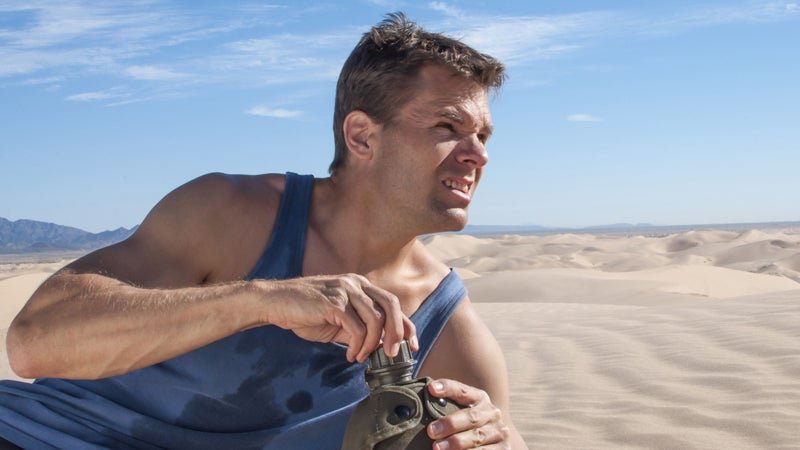When an explorer is dying of starvation in the wild, his voice takes on a peculiar deep tone.
The Hardest Way West
In this exclusive excerpt from the new book, Astoria, the legendary Overland Party attempts to establish America’s first commercial colony on the wild and unclaimed Northwest coast—provided, of course, they survive the journey.. “The alteration in our appearance was equally distressing to them… we were little more than skin and bone. The Doctor particularly remarked the sepulchral tone of our voices, which he requested us to make more cheerful if possible, unconscious that his own partook of the same key.”
Other strange physiological phenomena occur when the body is totally deprived of food, some that might be considered desirable, others not. The eyesight of one subject in a 1915 study improved dramatically on day 14 during a carefully monitored 31-day fast and was twice as acute at fast’s end as at the beginning. Others reported a peculiar lightness in their bearing. Heart rates can drop to 35 beats per minute. And there’s the nasty breath—breath that smells like a solvent such as acetone.
These observations came from controlled studies of fasting. , the Overland Party of John Jacob Astor attempt to found the first American colony on the West Coast, a kind of Pacific version of Jamestown, were not fasting. Rather, they were starving—they simply couldn’t find food—while traveling hard in winter’s cold, like Franklin’s party quoted above. Their caloric needs were enormous—as I wrote in my last blog posting, the energy demands of traveling hard on foot in winter can amount to an extraordinary 6,000 calories—or nine square meals—per day.
After abandoning their canoes, which had smashed among the waterfalls and rapids of a canyon, the 50-person Overland Party, led by Wilson Price Hunt, a young New Jersey businessman with no experience in the wilderness, split into two main groups in November, 1811. Trekking on foot, they followed the unknown river downstream toward what they hoped was the Pacific. Barren lava plains spread on both sides of the river gorge. With no game, and no fish appearing in their nets, they managed to trade with scattered bands of Shoshone Indians for a few dogs and horses. Consuming these—a group of 50 people trekking in winter could demolish the caloric equivalent of a large animal every few days, thus they traveled in two smaller groups—they chewed on bits of beaverskin and spare moccasins. Hunt stayed with the slower group, which included the family of the Indian interpreter, his pregnant wife, and their two toddler boys.
For a month, Hunt’s group struggled onward along the river. Then the river poured into a massive canyon—now known as Hell’s Canyon of the Snake River, the deepest canyon in North America. One snowy December day, as Hunt’s slow party struggled downstream over rocky outcrops, they spotted the other main party staggering back upstream on the opposite bank! This was the worst kind of news. Led by Scottish fur trader Ramsay Crooks, it had been stopped by the extreme depth and ruggedness of the canyon and the onset of winter’s deepening snows. Still worse, Crooks and his party verged on collapse from starvation and exhaustion due to the tremendous exertion and caloric needs.
Hunt had a small boat crafted from a horsehide and brought Crooks and a voyageur, Le Clerc, across the river from the starving party on the opposite bank. Crooks told him there was no way forward down the canyon on foot or boat. Hunt knew he now had to retreat upstream in hopes of finding Shoshone villages and food. They were at least ten days or two weeks away. Even after Hunt fed Crooks and Le Clerc the last of his horsemeat, however, they were still too weak to walk and became feebler with every moment. Hunt, loyal to a fault, trying to lead by consensus, wanted to stay with the dying men. Crooks was his friend and partner. But the 20 other members of his party, the voyageurs especially, harangued him to abandon Crooks and Le Clerc and retreat as hastily as possibly to the Shoshone villages and the hope of distant food.
“They said that we would all die from starvation,” wrote Hunt in his journal, “and urged me by all means to go on.”
The process had now begun for everyone.
The human body has a special mechanism to deal with starvation in these dangerous circumstances. A fascinating account on the physiology of human fasting can be found on the website . Drawing on the classic 1970 study “Starvation in Man” by George F. Cahill, the website tells us that the human body, even when starving, wants to continue to feed nutrients to the brain, despite all else. The starving human body also tries to hold onto a certain reserve of ready energy for “fight or flight” or other emergencies.
Normally, the fuel driving our bodies is glucose (a simple sugar) and glycogen (glucose transformed and stored in the muscles). We constantly drain this fuel supply to power our muscle movements and metabolism. We refill this fuel supply through eating.
But under fasting conditions—starvation—the body makes a peculiar switch. The muscles and heart stop using up all the ready fuel—glucose and glycogen—saving some of it for emergencies, and start to draw on fuel made from the breakdown of the body’s fat reserves and what’s called “ketone metabolism.”
“The glycogen reserves in humans never get completely depleted,” according to the website. “There is at all times a hepatic [liver] reserve, waiting to mobilize and rescue the organism from some sort of horrible situation.”
But the brain has to function, too, in order to save the starving human from “some horrible situation.” The human body is remarkable among animals in that the human brain can function with alternative energy supplies to glucose. Some of the body’s fats are converted to what’s known as “ketone bodies,” which, only in humans, have the ability to enter the brain and power it. (The human brain of a 150-pound male requires about 325 calories a day, or the equivalent of about one-and-a-half energy bars, to keep the lights on.) Thus by switching over to alternative energy supplies like ketone bodies, the brain, too, helps save the body’s glucose reserves (as well as the body’s muscle mass) for emergency “fight or flight” situations like a kind of human rocket fuel.
The “acetone breath” of starvation or fasting comes from the metabolism of these ketone bodies into byproducts like acetone, which is then dissipated through urine and through exhalation from the lungs.
Eventually, however, as the fats are used up, the body will begin to break down its own proteins—its muscles and tissues—and convert them to fuel. (None of the physiology of starvation or fasting that I’ve read explains the deep voices such as Franklin’s, but I wonder if it has something to do with the proteins of the vocal cords breaking down. Maybe a reader will know the answer.)
“An organism which is consuming its own protein is truly struggling,” according to derangedphysiology.com. “That said, if your [human] organism is struggling it has some 6kg or so of protein to get through before it dies.”
Ramsay Crooks and the voyageur Le Clerc had clearly entered this protein-consuming phase of starvation, and had finally used up whatever rocket-fuel reserves they had possessed.
Hunt, deeply conflicted, profoundly troubled—were his loyalties to his good but dying men, or to his leadership of the group as a whole?—finally abandoned the starving pair in the canyon depths. But he didn’t forsake them entirely. He left them two beaverskins to chew on, and promised that as soon as he found food, he would send it back to feed them.
Peter Stark is a full-time freelance writer of non-fiction books and articles specializing in adventure and exploration history. His most recent book, , tells the harrowing tale of the quest to settle a Jamestown-like colony on the Pacific Coast and will be published in March 2014 by Ecco/HarperCollins.


